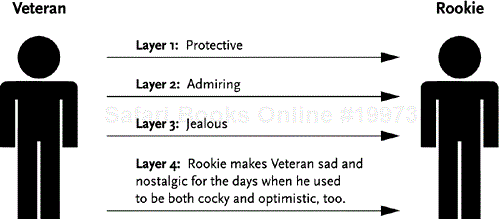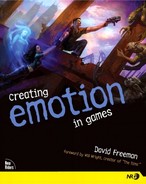Giving NPCs layers of feelings toward their fellow digital creations.
This chapter
illustrates ways, with very little reliance on dialogue, to make it feel like two NPCs have a rich and complex relationship.
Revisiting a thought from Chapter 2.4, if I were to ask you how you felt about your mother, father, brother, or sister, you might respond, “Well, that's kind of complicated….”
Which is exactly the point of this chapter. We often feel several emotions simultaneously toward a person. If we can capture this in the relationships between NPCs, we add to their life-likeness. If we don't, we've missed a great opportunity to create a more emotionally immersive environment.
Two NPCs can have layers of feelings toward each other.
Here's a hypothetical game example: You lead a SWAT team. On your team is a seasoned Veteran, as well as a Rookie. The truth is, the Rookie is braver and a better shot than the Veteran. The Veteran, however, is a smarter tactician and less likely to get the group killed.
In this kind of situation, I like to diagram the layers of feelings of each character toward the other. To simply this example, we'll focus on only the feelings of the Veteran toward the Rookie. The diagram could have one, two, three, or more layers.
For example:

In this relationship, the Veteran feels a variety of things toward the Rookie: (1) Protective, (2) Admiring, and (3) Jealous, and the Rookie makes him (4) Feel Nostalgic for His Youth.
I call this technique of a character feeling several layers of feelings toward another Layer Cakes. I use this expression because the image of a layer cake easily conjures the image of layers.
If you're designing a relationship like the one between the Veteran and the Rookie, you might decide that one or two of the layers the Veteran feels toward the Rookie are present more often than the others, or you may opt to give them all equal weight.
As will be discussed in greater detail in Chapter 2.22, “Revealing Complex Characters Through Their Actions,” I don't differentiate between dialogue and action. A Trait such as Courageous could be revealed through an NPC's courageous actions or through his or her dialogue.
In a similar way, if the Veteran possesses different layers of feelings toward the Rookie, then they could emerge in the Veteran's words, in his deeds, or in both.
Different layers could emerge at different places in the game, or several layers could be revealed close together or simultaneously.
Let's say your SWAT team is storming a house where a terrorist is thought to be holed up.
The Rookie advances, but when gunshots emerge from the house, the Veteran shoves him down and takes point.
(The above shows protectiveness—Layer 1 in the drawing.)
The Rookie charges into the house anyway. The Veteran turns to you. Veteran: Let's not let the imbecile get all the glory.
(The above shows both his admiration—Layer 2—and jealousy—Layer 3.)
You and the Veteran charge in after him.
So, in less than 15 seconds, we've presented three layers out of the four the Veteran feels toward the Rookie.
If, for some reason, we didn't want the scripted sequence of the Veteran pushing the Rookie down, we'd still have two of the Veteran's Feeling Layers toward the Rookie in the cinematic.
As we saw with the Veteran's speech, one line of dialogue (“Let's not let the imbecile get all the glory”) can reveal more than one Feeling Layer, just as one line of dialogue can reveal more than one Trait of a Character Diamond.
The layers of feeling that the Veteran has toward the Rookie need bear no relationship to the layers the Rookie feels toward the Veteran.
Their two characters' Layer Cakes toward each other are, in most cases, completely separate and unrelated.
The exception is when they fall into some kind of familiar and recognizable pattern, such as a father/son type of relationship, where both play out certain established roles. You could even tweak it to “critical father and rebellious son.”
Having the characters portray a familiar relationship as in the preceding is fine, but there are two possible pitfalls you must guard against.
Let's say the Veteran acts out the role of critical father, and the Rookie metaphorically takes on a role of delinquent son. If you make either character a cliché, the Great Emotioneer in the Sky who oversees us all will look down from on high and give you an F on your psycho/creative report card. For if you do fall into the cliché trap, you are not implementing the techniques in Chapters 2.1, “NPC Interesting Techniques,” and 2.3, “Dialogue Interesting Techniques.”
Another danger in using a familiar, metaphorical relationship such as this is that there's a tendency to do the opposite of Layer Cakes. That is, there's a tendency to have just one layer of feeling from each character toward the other. That's shallow. Layers are what cause Relationship Deepening.
And, of course, if the Veteran acts out the role of a critical father, there's absolutely no need whatsoever to have the Rookie act out the complementary role of rebellious son. As I mentioned earlier, in most cases there's not much of a relationship between the Layer Cakes the two characters feel toward each other.
NPC Toward NPC Relationship Deepening is particularly useful when you are part of a squad, platoon, team, strike force, or other continuing group. If this group is around you for a long period of time, then Layer Cakes can make the relationships between the characters richer.
Or, if you have two NPCs around you frequently, they can each have their own Layer Cakes toward each other.
As we saw with the Veteran and the Rookie, many layers can be conveyed quite quickly. Let's say you're working for a mob boss and a mob boss from another city enters the room. In just a quick exchange, using Layer Cakes, you can detect a quite complex relationship between the two.
